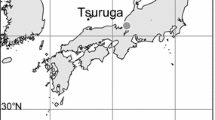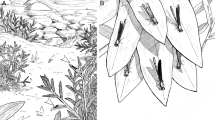Abstract
It has been demonstrated from free mating experiments using multiple males and females of the medaka, Oryzias latipes species complex, that lower-latitude males exhibit more active courtship behavior than higher-latitude males. In this study, courtship activeness in males from two latitudinal populations of Northern medaka, Oryzias sakaizumii, was measured in the presence of only one male and one female, where male–male interactions were completely eliminated. We found that males from the low-latitude population performed quick circles (i.e., courtship dance) and approached females more frequently than males from the high-latitude population. Moreover, the low-latitude males tended to start courtships sooner after encountering a female than the high-latitude males. Thus, the latitudinal variation in male courtship activeness persisted even in the absence of rival males. These probably reflect that sexual selection pressures are stronger at low latitudes.

Similar content being viewed by others
References
Andersson M (1994) Sexual selection, Princeton University Press, West Sussex
Arak A (1983) Sexual selection by male-male competition in natterjack toad choruses. Nature 306:261–262
Asai T, Senou H, Hosoya K (2011) Oryzias sakaizumii, a new ricefish from northern Japan (Teleostei: Adrianichthyidae). Ichthyol Explor Freshwaters 22:289–299
Awaji M, Hanyu I (1987) Annual reproductive cycle of the wild type medaka Oryzias latipes. Nippon Suisan Gakkaishi 53:959–965
Byers J, Hebets E, Podos J (2010) Female mate choice based upon male motor performance. Anim Behav 79:771–778
Candolin U (1999) Male–male competition facilitates female choice in sticklebacks. Proc R Soc B 266:785–789
Clara M, Amorim P, Almada VC (2005) The outcome of male–male encounters affects subsequent sound production during courtship in the cichlid fish Oreochromis mossambicus. Anim Behav 69:595–601
Clark L, Grant JWA (2010) Intrasexual competition and courtship in female and male Japanese medaka, Oryzias latipes: effects of operational sex ratio and density. Anim Behav 80:707–712
Darwin C (1871) The descent of man and selection in relation to sex. John Murray, London
Egami N, Terao O, Iwao Y (1988) The life span of wild populations of the fish Oryzias latipes under natural conditions. Zool Sci 5:1149–1152
Fujimoto S, Miyake T, Yamahira K (2015) Latitudinal variation in male competitiveness and female choosiness in a fish: are sexual selection pressures stronger at lower latitudes? Evol Biol 42:75–87
Iwamatsu T (2006) The integrated book for the biology of the medaka. University Education Press, Okayama
Kawajiri M, Kokita T, Yamahira K (2009) Heterochronic differences in fin development between latitudinal populations of the medaka Oryzias latipes (Actinopterygii: Adrianichthyidae). Biol J Linn Soc 97:571–580
Kagawa N (2014) Comparison of aggressive behaviors between two wild populations of Japanese medaka, Oryzias latipes and O. sakaizumii. Zool Sci 31:116–121
Morris M, Batra P, Ryan M (1992) Male-male competition and access to females in the swordtail Xiphophorus nigrensis. Copeia 1992:980–986
Ruzzante DE, Doyle RW (1991) Rapid behavioral changes in medaka (Oryzias latipes) caused by selection for competitive and noncompetitive growth. Evolution 45:1936–1946
Sutherland WJ (1987) Random and deterministic components of variance in mating success. In: Bradbury JW, Andersson MB (eds) Sexual selection: testing the alternatives. John Wiley, Chichester, pp 209–219
Suzuki Y, Miyake T, Yamahira K (2010) An acquisition trade-off with fast growth in a fish, the medaka Oryzias latipes: why do low-latitude ectotherms grow more slowly? Evol Ecol 24:749–759
Wong BBM (2004) Male competition is disruptive to courtship in the Pacific blue-eye. J Fish Biol 65:333–341
Acknowledgments
We would like to thank Kawajiri M, Fujimoto S, Abe M, Kiso S, Nakada T. Suzuki Y, Kobayasi M, Hara Y, and Makita T for assistance in keeping the experimental fish. We also thank Miyake T for his assistance in data analyses. Thanks are also due to Hanada H for making experimental containers. This study was partially supported by Grant-in-Aid for Scientific Research (20570019) from the Japanese Ministry of Education, Culture, Sports, Science and Technology to KY.
Author information
Authors and Affiliations
Corresponding author
About this article
Cite this article
Sasaki, T., Yamahira, K. Variation in male courtship activeness between latitudinal populations of Northern medaka. Ichthyol Res 63, 302–306 (2016). https://doi.org/10.1007/s10228-015-0484-5
Received:
Revised:
Accepted:
Published:
Issue Date:
DOI: https://doi.org/10.1007/s10228-015-0484-5




